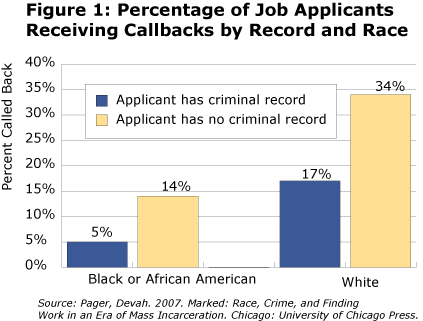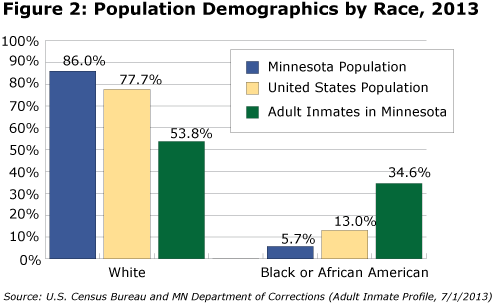by Edward Mallak
September 2015
Finding a job is one of the biggest barriers faced by people who are released from prison.
Most of the estimated 600,000 to 700,000 people who are released from prison each year need to find work.1 In Minnesota, 7,949 inmates were released from correctional facilities in 2013 and 7,639 in 2014.2 Unfortunately, it's estimated that three-fourths of ex-offenders nationwide remain jobless up to a year after release.3
Researchers found significant evidence that the longer former prisoners spend unemployed, the more likely they are to re-offend. Those who find stable jobs are less likely to commit further crimes. Unemployment is a major problem, both for the ex-offenders and society at large, as the lack of a steady income increases the likelihood of recidivism.
People face many employment barriers upon release from prison. First, ex-offenders traditionally lack formal education past high school. In Minnesota, only 22.4 percent of all convicts have any education past a high school diploma or GED, while 26.6 percent have less than a high school diploma or GED.4
In addition, prison causes a gap in one's employment history, which an employer is not likely to overlook on a resume. Not all inmates participate in work training and education programs, so a person's job skills can stagnate in prison.
In addition to their traditionally low level of job experience, ex-offenders also face a high level of stigma and negativity from employers. That is perhaps their biggest barrier to employment. For a variety of reasons, many employers will not consider hiring an ex-offender. Some jobs, like working with vulnerable populations or in certain financial fields, might be affected by state or federal regulations that restrict the job participation of someone with a felony conviction.
Another obstacle many ex-offenders face is having proper documentation, which some businesses require to verify employment eligibility. That is, some inmates do not have a valid Minnesota driver's license or state-issued identification card. They might not have access to those documents - if families have moved, for instance - once they are released. In other instances, so much time has passed that their documentation has expired or been lost.
Minnesota is one of three states with innovative programs that help ex-offenders regain documentation.
Based on a 2007 study, an employer is much less likely to hire an ex-offender. The chance of a callback after the employer looks at a white ex-offender's resume is half as high as the callback rate of a white non-offender. Black ex-offenders face an even harsher reality. Black ex-offenders are nearly three times less likely to receive a callback than black non-offenders (see Figure 1).5

Another study asked potential employers to share their thoughts on hiring ex-offenders. When asked to state their highest perceived risk of hiring an ex-offender, surveyed employers said theft (21 percent), lack of trustworthiness (15.9 percent) and violence in the workplace (9 percent) were most concerning. In addition, employers stated that having an ex-offender around would make themselves and their employees less comfortable in the workplace.6
In the United States, minority populations are overrepresented in prisons. Historically, Minnesota has had one of the highest rates of overrepresentation of African Americans in prisons.7 If the prison population was an accurate representation of the true Minnesota population, about 86 percent of all inmates would be white and 5.7 percent of inmates would be black in 2013.8 Instead, more than one in three inmates in Minnesota (34.6 percent) was black as of July 1, 2013 (see Figure 2).9

When combining this with the fact that black ex-offenders receive callbacks only 5 percent of the time from potential employers, it is evident how problems arise upon re-entry to society for ex-offenders, especially those who are black.
A number of programs, activities and policies are in place with the goal of giving ex-offenders a better chance at a smooth adjustment.
One thing prisoners can do to improve their opportunity for finding a job is to gain work experience or skills training while in prison. MINNCOR Industries is a business run by the Minnesota Department of Corrections that aims to give valuable work skills to convicts while they are still serving.10
One crucial skill that MINNCOR teaches is how to keep a job. Inmates are taught the importance of showing up on time and taking pride in their work. Approximately 20 percent of all inmates in Minnesota (1,545 people) work through MINNCOR.11
A sub-program of MINNCOR that has enjoyed much success is EMPLOY. Participants in the program are trained in various skills and trades, which improves their opportunities in the job market. A study of 464 offenders who were released from Minnesota prisons between 2006 and 2008 found that participants in EMPLOY were 35 percent less likely to be re-arrested and 72 percent more likely to find work upon release. EMPLOY participants earned on average $5,500 more than non-participants in the program.12
The Minnesota Department of Corrections also provides opportunities to inmates by allowing them to renew or apply for a new driver’s license while still in prison. In 2014, 1,319 inmates completed photo identification/driver’s license applications (13.3 percent of all inmates in Minnesota).13 A driver’s license is a huge advantage for ex-offenders, as it provides them the ability to drive a car and have ID for gaining employment, renting an apartment, opening a bank account or anything else that requires government identification.
“Ban the Box” is also helping ex-offenders find jobs after release. Seventeen states, including Minnesota, and many local governments have passed the Ban the Box law, which prevents employers from asking about an applicant’s prior convictions until later in the hiring process, thereby preventing some of the stigma related to having committed a crime. This bill became law in Minnesota on Jan. 1, 2014.14
One initiative to ensure that more ex-offenders get jobs soon after being released from prison is the Work Opportunity Tax Credit Program.15 This program provides employers with up to $2,400 (25 to 40 percent of the first $6,000 of first-year wages) if they hire and keep the newly released ex-offender on their payroll.16 This provides motivation to employers who are initially hesitant to hire former criminals. In one national study, 78 percent of employers stated that they would hire ex-offenders in the future as a part of the program.17
DEED also plays a role in helping ex-offenders find stable jobs. Ex-offenders — along with anyone else who qualifies — may participate in DEED’s workforce development programs, which can include training opportunities and one-on-one job counseling.
Since 2007, state workforce programs have served more than 15,720 participants who identified themselves as ex-offenders. Of these participants, one in three (36.2 percent) had less than a high school diploma or equivalent. Additionally, nearly half (48 percent) of ex-offender participants were from communities of color.
At the time these ex-offenders enrolled, just over half (55.5 percent) were unemployed for one or more weeks. Their difficulty in finding employment is reflected in the length of time without a job. Nearly 60 percent of participants who were unemployed ex-offenders had been out of work 26 weeks or more at program enrollment — often the threshold for being classified as being long-term unemployed — compared with 40.5 percent of the non-offender participants.
The job outlook for ex-offenders has not always been the best. Employers might be reluctant to hire them, and ex-offenders often lack the skills or resources needed to get and maintain a job. The combination leads to a high rate of recidivism. Programs both inside and outside of Minnesota prisons, however, help these inmates get the skills they need.
In addition, initiatives like the Work Opportunity Tax Credit and the Ban the Box law help ease some of the challenges faced by ex-offenders seeking employment. The growth of these programs and others like them will improve the chances of ex-offenders assimilating back into society and becoming productive citizens.
1Pager, Devah. 2007. “Marked: Race, Crime, and Finding Work in an Era of Mass Incarceration.” Chicago: University of Chicago Press.
22014 Department of Corrections inmate profile.
3Pager, Devah. 2007. “Marked: Race, Crime, and Finding Work in an Era of Mass Incarceration.” Chicago: University of Chicago Press.
4Minnesota Department of Corrections inmate profile, Jan. 1, 2015.
5Pager, Devah. 2007. “Marked: Race, Crime, and Finding Work in an Era of Mass Incarceration.” Chicago: University of Chicago Press.
6Pager, Devah and Bruce Western. “Investigating Prisoner Reentry: The Impact of Conviction Status on the Employment Prospects of Young Men.” U.S. Department of Justice, October 2009.
7Frase, Richard S. “What Explains Persistent Racial Disproportionality in Minnesota’s Prison and Jail Populations?” Crime and Justice, Vol. 38, No. 1 (2009), pp. 201-280.
8U.S. Census Bureau.
9Minnesota Department of Corrections, adult inmate profile, July 1, 2013.
10MINNCORR.
11MINNCORR
12Chandler, Brenda. “Reentry Success at MINNCOR”.
13Minnesota Department of Corrections, Performance Report 2014.
14Minnesota Department of Human Rights, “Ban the Box Overview for Private Employers”.
15The legislative authority for the Work Opportunity Tax Credit (WOTC) Program expired on Dec. 31, 2014. In the past when the program’s authority lapsed, Congress reauthorized the program back to the date of expiration. In anticipation of possible retroactive authorization, employers should continue to submit their timely WOTC applications for all targeted groups to state workforce agencies.
16U.S. Department of Labor, Work Opportunity Tax Credit.
17Pager, Devah and Bruce Western. “Investigating Prisoner Reentry: The Impact of Conviction Status on the Employment Prospects of Young Men.” U.S. Department of Justice, October 2009.